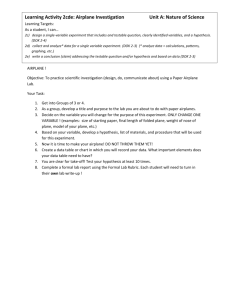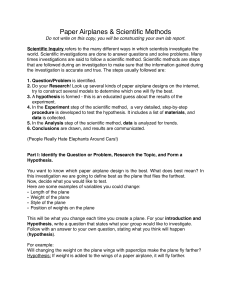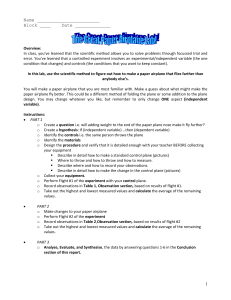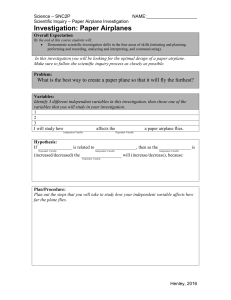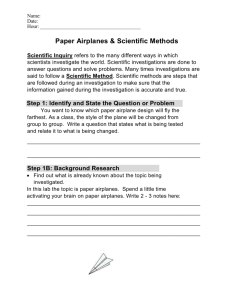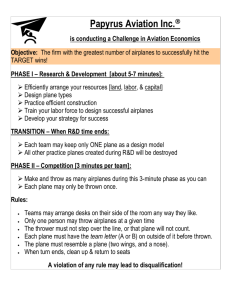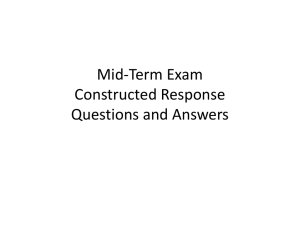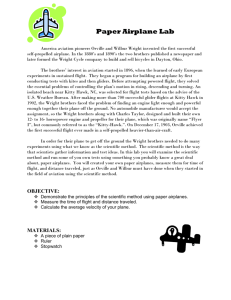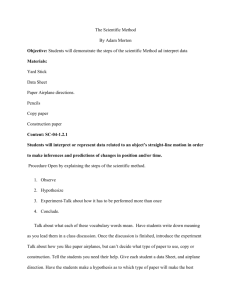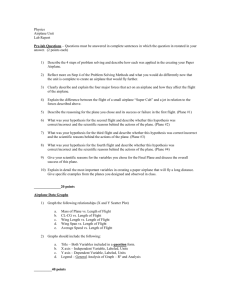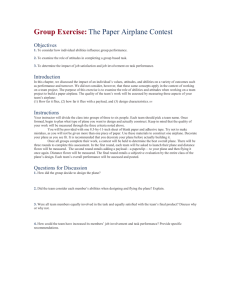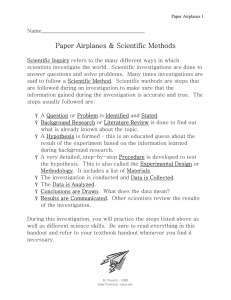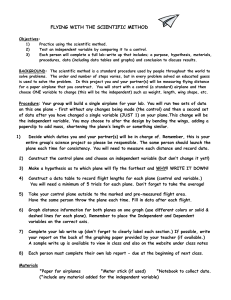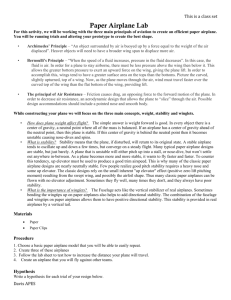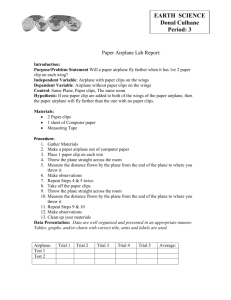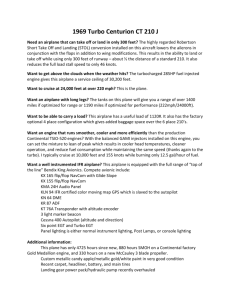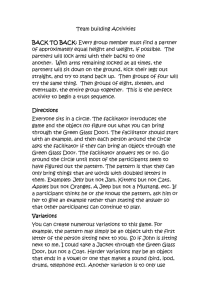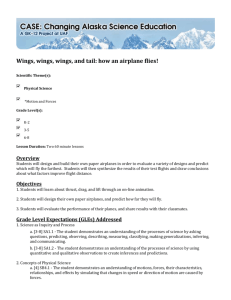The Scientific Paper Airplane Method
advertisement
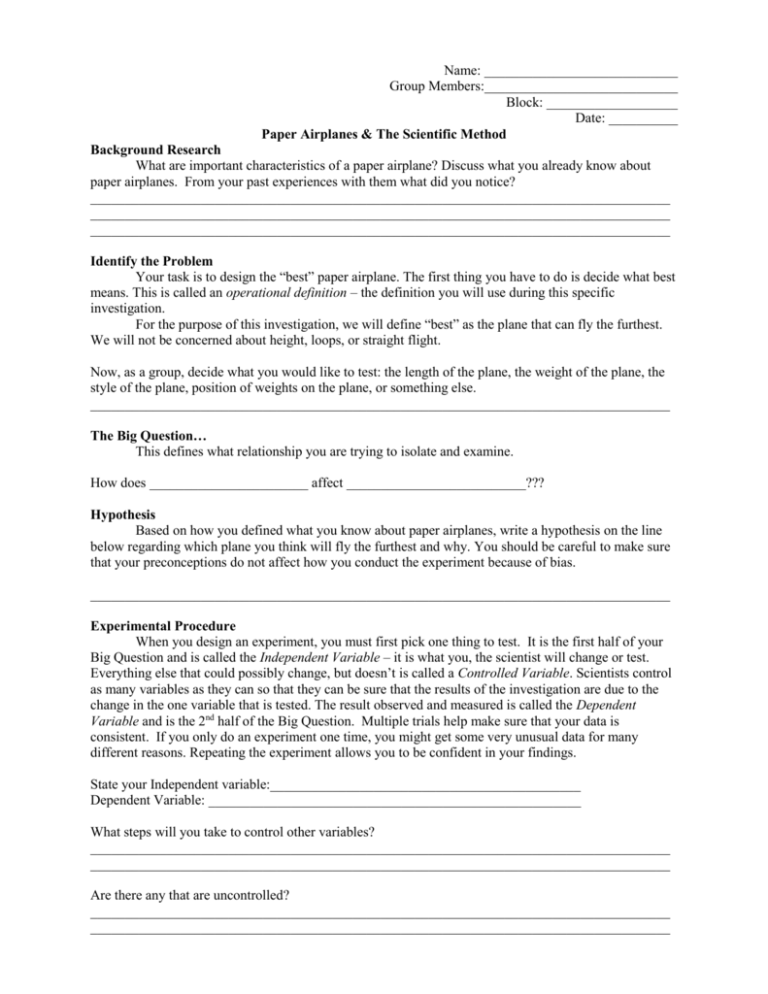
Name: ____________________________ Group Members:____________________________ Block: ___________________ Date: __________ Paper Airplanes & The Scientific Method Background Research What are important characteristics of a paper airplane? Discuss what you already know about paper airplanes. From your past experiences with them what did you notice? ____________________________________________________________________________________ ____________________________________________________________________________________ ____________________________________________________________________________________ Identify the Problem Your task is to design the “best” paper airplane. The first thing you have to do is decide what best means. This is called an operational definition – the definition you will use during this specific investigation. For the purpose of this investigation, we will define “best” as the plane that can fly the furthest. We will not be concerned about height, loops, or straight flight. Now, as a group, decide what you would like to test: the length of the plane, the weight of the plane, the style of the plane, position of weights on the plane, or something else. ____________________________________________________________________________________ The Big Question… This defines what relationship you are trying to isolate and examine. How does _______________________ affect __________________________??? Hypothesis Based on how you defined what you know about paper airplanes, write a hypothesis on the line below regarding which plane you think will fly the furthest and why. You should be careful to make sure that your preconceptions do not affect how you conduct the experiment because of bias. ____________________________________________________________________________________ Experimental Procedure When you design an experiment, you must first pick one thing to test. It is the first half of your Big Question and is called the Independent Variable – it is what you, the scientist will change or test. Everything else that could possibly change, but doesn’t is called a Controlled Variable. Scientists control as many variables as they can so that they can be sure that the results of the investigation are due to the change in the one variable that is tested. The result observed and measured is called the Dependent Variable and is the 2nd half of the Big Question. Multiple trials help make sure that your data is consistent. If you only do an experiment one time, you might get some very unusual data for many different reasons. Repeating the experiment allows you to be confident in your findings. State your Independent variable:_____________________________________________ Dependent Variable: ______________________________________________________ What steps will you take to control other variables? ____________________________________________________________________________________ ____________________________________________________________________________________ Are there any that are uncontrolled? ____________________________________________________________________________________ ____________________________________________________________________________________ Collect & Record Data Airplane Flight Distance (meters) (Insert your IV here) Trial 1 Trial 2 __________________ Trial 3 Your group set up the lab and collected data together. However, everything below the line must be done on your own!! Analyze Data The first step in analyzing data is to organize your data and do any necessary calculations. In this case, all that is needed is to calculate the average distances. o All data tables have some things in common The independent variable is in the first column. The dependent variable is in the last column. Each column is labeled to identify the variables. Units of measurement are included in the labels (not in the cells). The data table has a descriptive title of the form: How does X affect Y? What is the Effect of X on Y? Y vs X A graph can help you visualize the patterns, trends, and relationships in your experiment. It is very important to use the right kind of graph when analyzing data: o Discrete variables have a set number of possibilities (shape, shoe size, location, etc) and should be represented by a Bar Graph. o Continuous variables have an infinite number of possibilities (time, length, speed, etc) and should be represented by a Line Graph. o All graphs have some things in common: The independent variable is on the X-axis (bottom). The dependent variable is on the Y-axis (side). Each axis is labeled to identify the variables with units in ( ) Each axis has consistent intervals, which are also labeled. The information on the graph is spread out so that most of the graph is used. The graph has a descriptive title of the form: How does X affect Y? What is the Effect of X on Y? Y vs X Draw Conclusions The following items should be addressed in a good conclusion: 1. Results are described and explained, and the hypothesis is accepted or rejected. (Note: A hypothesis is never “right” or “wrong” – it is either supported by the data or it is not supported by the data). ____________________________________________________________________________________ ____________________________________________________________________________________ ____________________________________________________________________________________ ____________________________________________________________________________________ 2. The assumptions and limitations of the experiment ____________________________________________________________________________________ ____________________________________________________________________________________ ____________________________________________________________________________________ ____________________________________________________________________________________ 3. How the investigation can be improved ____________________________________________________________________________________ ____________________________________________________________________________________ ____________________________________________________________________________________ ____________________________________________________________________________________ 4. Other questions raised during the investigation that could be explored in future investigations ____________________________________________________________________________________ ____________________________________________________________________________________ ____________________________________________________________________________________ ____________________________________________________________________________________ 5. Applications/usefulness of findings. ____________________________________________________________________________________ ____________________________________________________________________________________ ____________________________________________________________________________________ ____________________________________________________________________________________ Communicate Results Be prepared to spend a few minutes discussing the results of your investigation with your scientific colleagues (classmates). Data Presentation: Airplane Flight Distance (meters) (Insert your IV here) Trial 1 Trial 2 Trial 3 Average Distance
